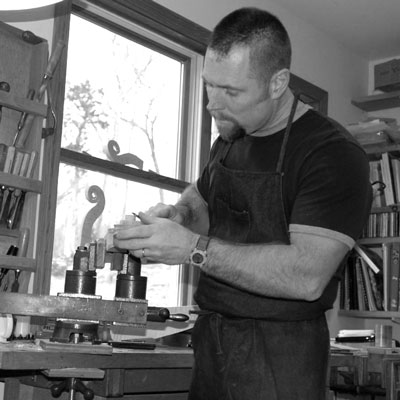Exhibiting Cello Makers
Daniel Arlig
Daniel Arlig studied Jazz Double Bass Performance at New England Conservatory, before becoming interested in violin making. He began studies in instrument repair at Minnesota State College in Red Wing, Minnesota, then returned to Boston to train in violin making and restoration at the North Bennet Street School, where he worked with Kevin Kelly, David Polstein, and Thomas Hummel. After graduating in 2002, Arlig returned to Minnesota, where he apprenticed with John Waddle in Minneapolis, before establishing his own workshop there.
Arlig currently builds violins, violas, and cellos, while performing regularly as a multi-instrumentalist in the Twin Cities area. He was awarded an Honorable Mention in the 2012 Art of Sound Violin Making Competition and is a member of The Violin Society of America.
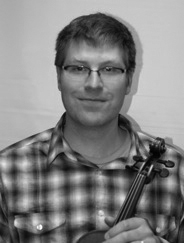
Michèle Ashley
American luthier Michèle Ashley was raised in the United States and completed her secondary education in France, where she studied cello and ethnomusicology. At age 19, she moved to Italy to train as a violin maker at the International School of Violin Making in Cremona, where she worked with G. B. Morassi and Pietro Sgarabotto. Ashley established her own workshops in Parma and later Verona, where she studied briefly with Renato Scrollavezza. Moving to Mantua, Ashley then apprenticed with Mario Gadda, for whom she worked and made copies for many years. Several of Ashley’s instruments of that period are being played on in major symphonies throughout Europe and Asia.
In 1985, Ashley moved to Boston, where she began to focus primarily on building cellos. She has made over 130 instruments, owned and played by professional symphony musicians, students, and faculty of the top conservatories in the country. In 2004, she opened a second shop in Montréal, Quebec, and lives and works between Canada and the U.S.
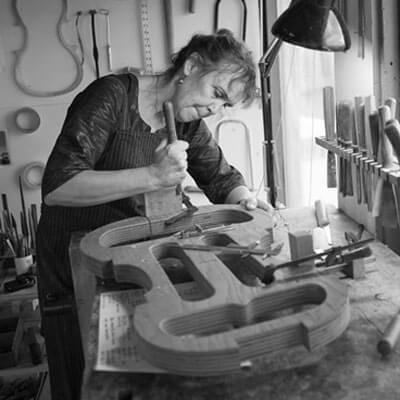
Peter Bingen
Peter Bingen was born in Los Angeles in 1974, and was raised in the American Midwest. A strong passion for art and a career in woodworking led him to the North Bennet Street School in Boston, where he graduated from the Violin Making and Repair Program in 2006. He has worked for violin maker David Gusset, and maker and restorer Andrew Carruthers.
He currently works from his studio in Santa Rosa California, where he makes new instruments and performs restorations, repairs, and setup work. His own instrument models include violins based on Stradivari and Guarneri, Brescian-style violas, and Venetian model cellos. He received a Certificate of Merit for violin tone from the Violin Society of America Competition in 2006, and First Prize from the Art of Sound Competition in 2012.
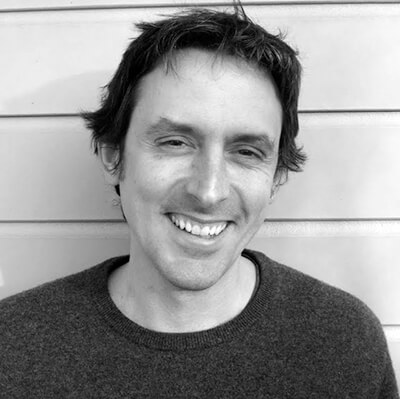
Eric Caldwell
A sixth generation woodworker from Lawrence, Kansas, Eric Caldwell’s interests in violin making came from his family history as well as a personal interest in music. While studying oboe in California, Caldwell had the opportunity to study violin making with Karl Roy in a summer workshop, and continued his studies for several more years at the University of New Hampshire Summer Violin Craftsmanship Institute.
Caldwell worked in instrument repair for various workshops throughout the U.S. before taking a job with Potter Violin Company in 2006, where he was appointed Repair Department Manager. He left the firm in 2009 to establish his own workshop.
He has won several awards for his instruments, including a Certificate of Merit for Violin Tone in the Violin Society of America competition of 2010, and was invited to include two violins at The Art of Sound 2011 Exhibition.
Andrew Carruthers
A native of Oxfordshire, England, Andrew Carruthers worked at the Lawrence Berkeley Research Labs before deciding to follow his passion for building stringed instruments. He studied at the Welsh School of Violin Making and Repair, near Cardiff, then moved to the United States to join the restoration workshops of Bein & Fushi in Chicago, where he apprenticed with master cello restorer, Russell Wagner.
In 1996, Carruthers opened his own workshop in Santa Rosa, California, providing restoration services to some of the leading dealers in the violin trade. He currently spends his time crafting his own violins, violas, and cellos for musicians throughout the U.S. and Europe.
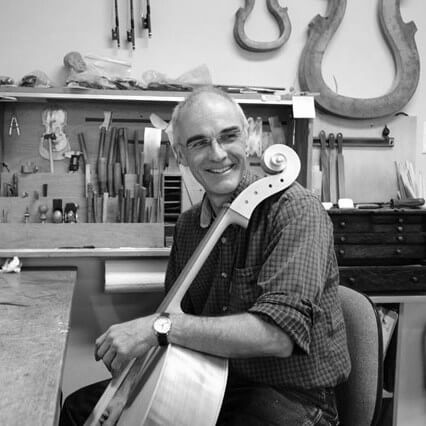
John Dailey
Discovering an interest in violins at a young age, John’s failure at age 15 to make a fine violin in the family garage only impelled him to learn more. Although John was offered an apprenticeship at an established violin shop, he waited until after high school to pursue what he knew would be a lifelong study of violin making.
At the Violin Making School of America in Salt Lake City from 1999 to 2003, John studied music theory, art, technical drawing, varnish, and violin making and its history. Upon graduating, John continued his studies by apprenticing with various luthiers, including John Young and Ryan Soltis.
John joined Carriage House Violins in 2008. Training with the shop’s technicians has enabled him to continue his journeymanship and to fine-tune his skills in instrument setup, tonal adjustment, making, and restoration.
John thoroughly enjoys being able to see and study historical instruments on a daily basis at Carriage House Violins. As a violin maker he believes there is nothing more important than to study the work of the masters.
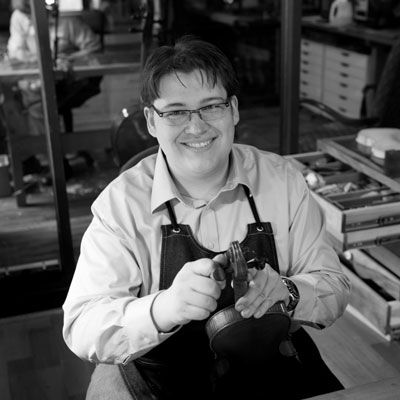
Gary Davis
American cello maker and restorer Gary Davis has served as a luthier for over 25 years. His cellos have won numerous awards, including Silver Medals for Cello Tone at the Violin Society of America competitions of 2002 and 2006. Based in Foxborough, Massachusetts, Davis heads a full service shop, where he builds new cellos and provides tonal adjustments and restoration for distinguished clients, including cellists Andrés Díaz, Sergey Antonov, and Terry King. Davis also holds a Bachelor of Music degree in Cello Performance from the Boston Conservatory of Music.
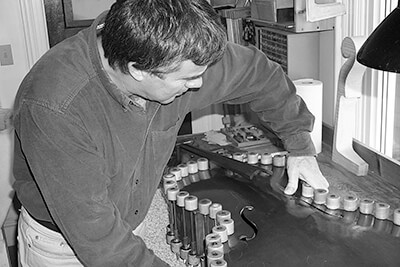
Michele Dobner
Italian luthier Michele Dobner (b. 1967) is a native of Vicenza, Italy. He trained in violin making and restoration in Milan, before moving to Madrid, Spain to work with Jose Maria Lozano. He now resides in Cremona, where he builds and restores instruments.
At the 2008 Violin Society of America competition, Dobner won two Silver Medals for cello and for a quartet. In both 2009 and 2012, he was a finalist at the Cremona Triennale lutherie competitions. He was also a founding member of “Stradivariazioni,” a Cremonese makers’ group which hosted concerts and contemporary instrument exhibitions at the famous Stradivari House, where Stradivari worked and lived.
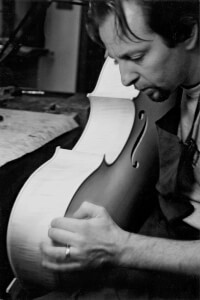
Nicholas Gilles
French luthier Nicolas Gilles (b. 1977) is a native of Montpellier, France, where he expressed an interest in music from a very early age, training both as a musician and instrument maker. He studied at the Mirecourt and Newark Schools of Violin Making, before working for Charles Luc Hommel in Marseille in restoration. In 2000, Gilles returned to Montpellier to work with Frederic Chaudiere, then established his own workshop in 2001.
Gilles has won the highest honors for his instruments, most notably at the Violin Society of America Competition of 2004, in which he won the Gold Medal for Quartet, as well as a Gold Medal for viola, and a Silver Medal for cello workmanship. In subsequent VSA competitions, he won Silver Medals for his cellos in 2008 and 2010, and in 2012, won another Silver Medal for cello craftsmanship, as well as a Silver Medal for sound for his Quartet. For his cello entered into the “VioloncellenSeine” cello making competition of 2014, he won a sound award from cellist Eric Picard. His instruments are in high demand.

Gary Garavaglia
Gary Garavaglia is one of the most prolific makers in recent history. The first twenty five years of his career were devoted solely to making cellos based on Stradivari, Guarneri, and Montagnana, as well as his personal models. To date, he has made and sold over 400 violins, violas, and cellos.
Born and raised in Detroit, Michigan, Garavaglia studied at the former Kenneth Warren School (now the Chicago School of Violin Making) in Chicago, Illinois. For much of his career, he has worked exclusively with William Harris Lee and Company in Chicago.
Garavaglia’s instruments are sought after by students and professionals alike.
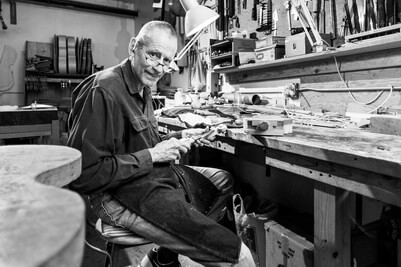
Grubaugh & Seifert
Acclaimed makers and restorers Joseph Grubaugh (b. 1950) and Sigrun Seifert (b. 1954) have been working partners for more than 35 years in the San Francisco Bay Area, where they also raised their two children. Sigrun studied at the Mittenwald School of Violin Making, and Joseph studied with Albert C. Muller. The couple met in Los Angeles while working at Hans Weisshaar's workshop, before moving to San Francisco to establish their own business. Grubaugh & Seifert instruments have won multiple awards for tone and workmanship in international competitions, including five Gold and four Silver medals at competitions held by the Violin Society of America, receiving the Hors Concours designation in 1998. Both have presided as judges at the VSA and other international competitions, taught at the VSA's Violin Making and Restoration Workshops at Oberlin College, written numerous articles for The Strad and Strings magazines, lectured extensively, and are sought after for their restoration expertise on important antique instruments. Grubaugh & Seifert instruments are owned by leading players in major orchestras throughout the world.
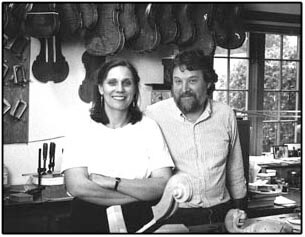
Kile Hill
Kile Hill studied cello as a child and became interested in violin making after watching a television documentary on PBS. He studied cello performance at University of Tennessee at Chattanooga, before attending the Violin Making School of America in Salt Lake City, Utah in 2000.
Hill has worked with Scoggins & Scoggins Violins, Ryan Soltis, and Stephanie Voss in Atlanta. He currently works from a home studio in McMinnville, Oregon.
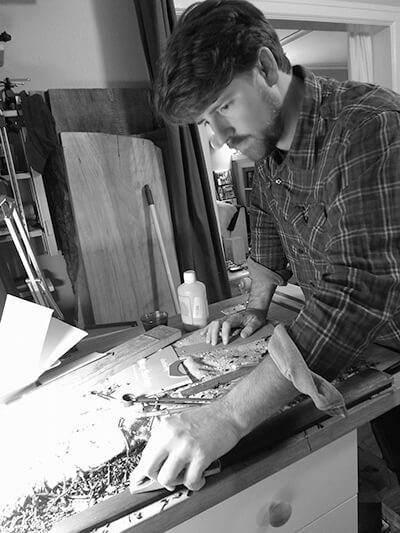
Christopher Jacoby
Christopher Jacoby (b. 1981) studied violin making at the Violin Making School of America in Salt Lake City, Utah, and repair and restoration with Peter Prier.
Jacoby is a member of the Violin Society of America, where he serves on the Board of Directors, and is the Editor of the membership magazine, The Scroll. He is a regular contributor to Strings magazine, often penning the “Ask The Expert” column, as well as other industry periodicals. Currently the luthier in residence at The Violin Shop in Lincoln, Nebraska, Jacoby has over 120 instruments to his credit.
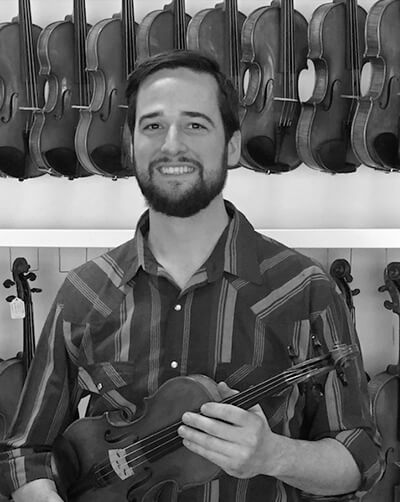
Kevin Kelly
Kevin Kelly was born in the Berkshire hills of Western Massachusetts, near the summer home of the Boston Symphony. As a child he became fascinated by the violin and absorbed many different styles of violin playing. He has been a professional musician and also spent time in his early twenties as a woodworker, building custom homes. Violin making allowed him to combine many otherwise disparate interests: violin music, woodworking, and geometric design. His career has taken him from Boston to San Francisco, to London, and back again - all the while working and studying in some of the finest violin shops in the world. He was a teacher at the North Bennett Street School in Boston before opening his own studio in 2002.
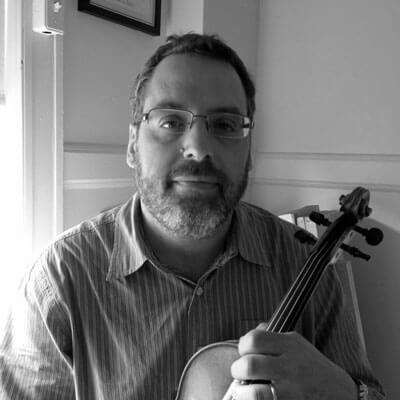
Min Sung Kim
Korean maker Min Sung Kim (b. 1971) studied at the Violin Making School of America in Salt Lake City, Utah with Peter Prier, before moving to Cremona, Italy to study with Primo Pistoni and Alessandro Voltini at the International Violin Making School. He is a member of the Consortium of Violin Makers “Antonio Stradivari” Cremona.
Sung’s instruments have won numerous awards in international competitions, including a Bronze Medal for Cello at the 2006 at the Cremona Triennale lutherie competition in 2006; a Certificate of Merit for Cello Tone at the Violin Society of America in 2006; Fourth place for Cello Tone at the Manchester International Competition of Cello Making in 2007; a Gold Medal at the Pisogne Italian National Violin Making competition of 2008; a Silver Medal for Cello at the Pisogne competition in 2009; a Gold Medal for Best Cello Setup in the China International Violin Making competition in Beijing in 2010; a Silver Medal and Best Workmanship for Cello, and Fourth place prize for Viola at the Mittenwald competition of 2010; a Certificate of Merit for Quartet Workmanship at the VSA in 2010; a Gold Medal and Best Setup for Cello at the Henryk Wieniawski Violin Making competition in Poland in 2011; a Silver for Viola, and a Bronze for Violin in the China International competition in Beijing 2013.
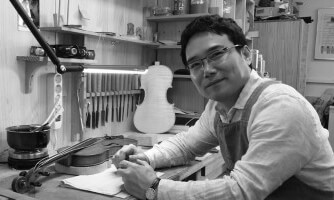
James McKean
Celebrated American luthier James McKean was among the first group of students at the Violin Making School of America, founded in Salt Lake City, Utah in 1973. He then worked with Vahakn Nigogosian in New York City before opening his own workshop in 1981.
A prolific and award-winning maker of violins, violas, and cellos, McKean is also a corresponding editor for Strings Magazine, for whom he has written extensively on all aspects of the violin over the past 30 years. His articles also appear in The Strad, and his recent memoir, Art’s Cello, was selected by its publisher, Kindle Singles, as one of the 20 best books of 2014.
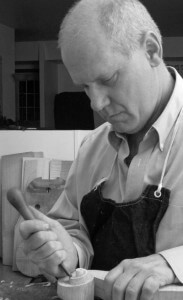
Raymond Melanson
Ray Melanson studied art and violin performance at the University of Lowell in Massachusetts in the mid 1970s, before becoming interested in violin making. At the University of Rhode Island, he studied bow rehair and repair with Arnold Bone and violin repair with Hans Nebel, then traveled to Salt Lake City, Utah to study violin making with Peter Paul Prier at the Violin Making School of America. Ray returned to Massachusetts in 1983 to found the Violin Making and Repair program at the North Bennet Street School in Boston, where he taught for four years, while continuing to restore stringed instruments and build his own violins, violas, and cellos. He now maintains his own workshop in Rochester, MA.
Melanson’s violins have received 14 awards at the International Violin Making competitions held by the Violin Society of America. Three of his instruments have won Silver Medals for tone, and most recently, he won a Gold Medal for tone at the 2012 Art of Sound International Competition. During his 30 years as a violin maker, he has built over 300 instruments, 80 of them cellos. His instruments are owned by musicians all over the world, including many well-known soloists, players in major symphony orchestras, and recording artists.
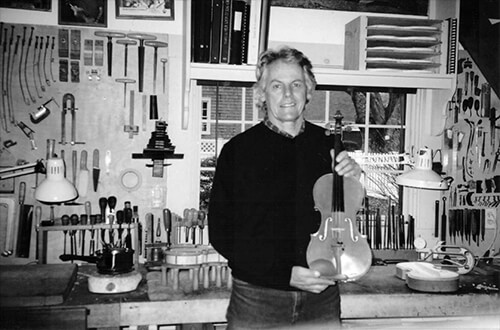
Guy Rabut
Guy Rabut was raised in a musical and artistic family where he began to play the cello at the age of nine. Along with his musical studies, he also developed a strong interest in the visual arts through his father, an artist by profession. This seminal association with music and art led to his career in violin making which began at The Violin Making School of America in Salt Lake City, Utah, where he graduated in 1978.
After working for five years at the prestigious firm of Jacques Français in New York City under Master restorer René Morel, Rabut established his own shop in New York City in 1984, dividing his time between making and restoring instruments. In 1992, with the opening of a workshop in Carnegie Hall, he began to focus exclusively on creating new violins, violas and cellos. Established over 30 years in New York, Rabut continues his dedication to new instruments in his workshop in the Chelsea district of Manhattan.
He has been featured in numerous articles and interviews in magazines and radio programs, and was the subject of a short film by Laredo Montoneri in 2014.
His instruments have won several awards in international competitions, and are owned by professional musicians throughout the world.
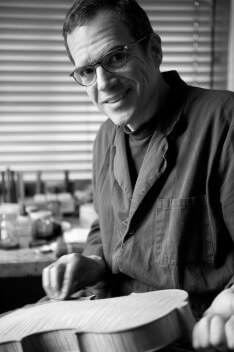
Raymond Schryer
Raymond Schryer is one of the most distinguished authorities on violin making in the world today. Born in Canada in 1961 to a musical family, he became a champion fiddler, leading the way for his younger triplet brothers, who would form the renowned group The Schryer Triplets.
At age 14, Schryer began building violins with his uncle, Fernand Schryer in Quebec, before attending the University of Western Ontario to pursue a degree in violin performance. He then returned to violin making, serving a three-year apprenticeship in the workshop of George Heinl & Company in Toronto.
Schryer’s instruments have won numerous awards in international competitions, including the Triennale "Antonio Stradivari" Competition in Cremona, Italy, where he won a gold medal for cello in 2003 and a silver medal for violin in 2009. The cello is now displayed in Cremona's Museo del Violino, which houses one of the world’s finest collections of classical Cremonese instruments, as well as an interactive contemporary collection of instruments from first prize winners of the Triennale Competitions. Other honors include a bronze medal for cello in the 1994 Tchaikovsky Violin Making Competition in Moscow, and multiple awards in competitions held by the Violin Society of America between 1992 and 2008.
A leading innovator in the application of new technologies in violin making, Schryer has presented his extensive research at conferences, and has published numerous articles in The Strad and Strings magazines. He teaches at violin making schools and workshops worldwide, frequently serves as a judge in international competitions, and serves on the board of the American Federation of Violin and Bow Makers. His instruments are in high demand among professional players.

Nathan Slobodkin
Nathan Slobodkin is a native of Ann Arbor, Michigan, whose more than 40 years in the musical instrument field include an internship in the musical instrument collection of the Smithsonian Institution, five years of building instruments in the W. H. Lee workshop in Chicago, two years on the restoration staff of Jacques Français Rare Violins in New York, and a twelve-year collaboration with Reuning & Son Violins in Boston, producing more than 70 cellos modeled after the famous Ex-Messeus Guarneri del Gesù. He has provided services for many of the top violin shops around the United States and his instruments have been sold in Europe, Asia, and across North America.
Slobodkin was awarded a Certificate of Merit for workmanship by the Violin Society of America in 1996 and a second prize for violin making at the Art of Sound International Violin Making Competition in 2014. He has recently attended professional development workshops at the Violin Society of America’s Violin Making Workshops at Oberlin Conservatory and at the Emerson Arts Centre.
Since 1993, Slobodkin has operated his own business in Bangor, Maine, where he makes new instruments in all price ranges to meet the demands of the most discriminating students and professional musicians.
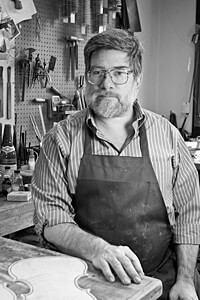
Jason Starkie
In 2011 Jason Starkie opened a shop in Seattle producing fine cellos and violins under his own name for serious musicians including Lori Goldston and Ronald Thomas.
Jason apprenticed in the shop of Viseltear and Young, NYC, during the early 0s then moved to France to continue as Robert Young’s assistant.
His cello models are a 1690 Giovani Grancino, based on analysis of Francois Denis, and more recently, a cello suitable for smaller players, after Paganini’s 1717 Pietro Giacomo Rogeri.
His violin model is the Plowden del Gesu informed by work at Oberlin.
Jason continues to enrich his practice with the Maker’s and Acoustics workshops at Oberlin and engages in further investigations of optimizing issues of the tone and playability of instruments with Kevin Krentz. Jason is also participating in the VSA’s New Professionals program currently developing its scope and goals.
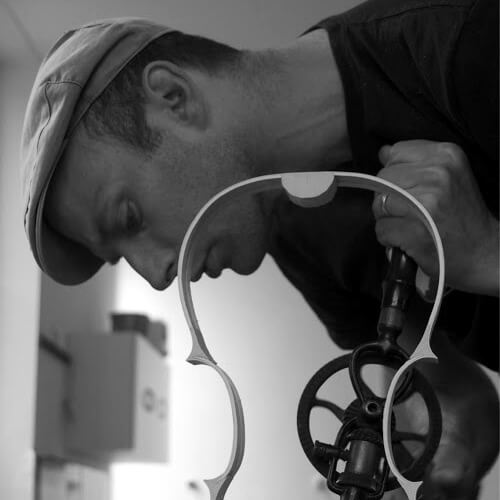
Jean-Benoit Stensland
Canadian luthier Jean-Benoît Stensland (b. 1960) began his apprenticeship in Montréal under Antoine Robichaud. Awarded a Canada Art Council grant in 1980, Stensland went to Italy to study at the International School of Violin Making in Cremona. Stensland returned to Canada in 1984 to open a workshop with luthier Thérèse Girard in downtown Montréal, where he has made more than 350 instruments, including over forty cellos. His numerous awards include a Certificate of Merit for a violin at the Violin Society of America in 1984. One of Stensland’s cellos is in the collection of the renowned Canadian Museum of Civilization in Québec. His instruments are owned by professional players worldwide.
Gregory Walke
Canadian luthier Gregory Walke (b. 1952) studied violin making at the Welsh School of Violin Making and Repair. He worked for several years in Wales, then in Germany with Hieronymus Koestler in Stuttgart, before returning to his native Canada.
In 1988, Walke established a studio with Sibylle Ruppert in Paisley, Ontario, where he worked as a restorer for top North American shops, including Moes & Moes. He also has collaborated with his his brother, bow maker Bernard Walke. He currently dedicates his time solely to making his own instruments.
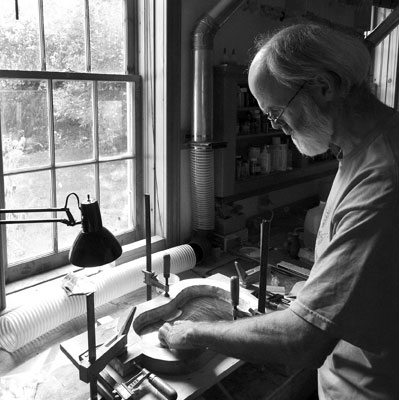
William Whedbee
A native of Hawaii, American luthier William Whedbee (b. 1952) attended the University of Chicago, where he studied with Italian sculptor Virginio Ferrari and with musicologist Howard Brown. This combined interest in music and wood sculpture led to his traveling to Cremona, Italy in 1976 to train at the Institute of Violin Making.
Whedbee returned to Chicago in 1979 at the invitation of William Harris Lee to found and develop a violin making workshop there. During his twelve years with Lee, he built more than 400 violins, violas and cellos, as well as training and supervising nearly twenty violin makers from around the world.
Since 1992, Whedbee has worked independently in his own workshop on Chicago's North Side, focusing primarily on building cellos in response to growing demand from players and teachers. He has now completed more than 200 cellos, 275 violins, and almost 300 violas. His cellos have been praised by some of today’s top cellists, and are in high demand among students and professionals from all over the world.
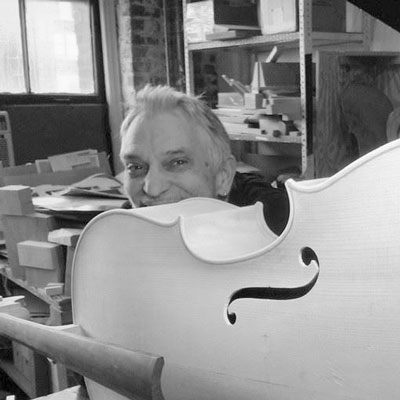
Lawrence Wilke
Lawrence Wilke’s interest in musical instruments began when he started playing cello at 8 years old. He began his studies with Marijane Carr Seigal of the Lyric Opera of Chicago, who also taught his uncle violin maker David Caron. He completed his cello studies from 1981-84 with Dr. William Klenz of SUNY Binghamton.
He began his apprenticeship as a violin maker in 1978 at the age of 16 with his uncle, master violin maker David Caron. During this time he also studied bow making and repair with Philip Krause. In 1986 he completed his studies when he went to work for Andrew Dipper in Taynton England where he studied design and restoration. In 1988 he opened his own studio making violins, violas and specializing in cello making.
